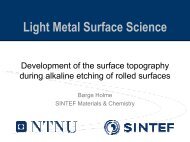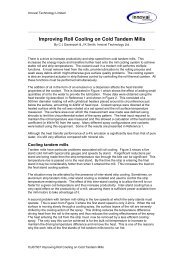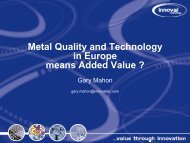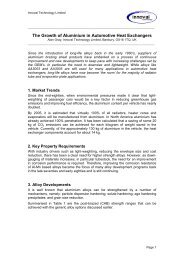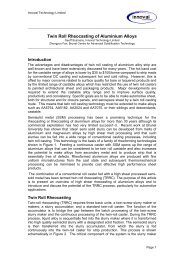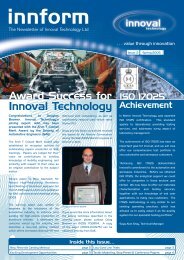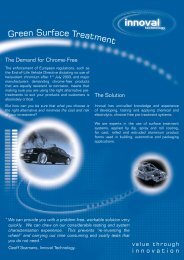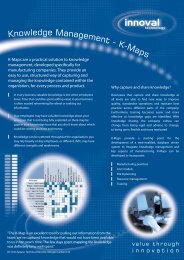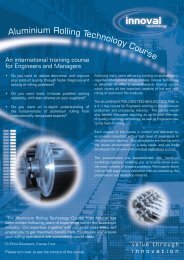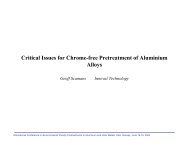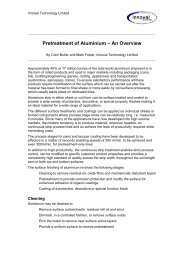Designing a World-Class Downstream Aluminium Plant - Innoval ...
Designing a World-Class Downstream Aluminium Plant - Innoval ...
Designing a World-Class Downstream Aluminium Plant - Innoval ...
Create successful ePaper yourself
Turn your PDF publications into a flip-book with our unique Google optimized e-Paper software.
<strong>Designing</strong>, Mannin<br />
ng and Operating a<br />
<strong>World</strong>-<strong>Class</strong> <strong>Downstream</strong> Business<br />
Dr Tom Farley<br />
Managing Director<br />
<strong>Innoval</strong> Technology Ltd
Summary of Presentation<br />
• <strong>Innoval</strong> Technology<br />
‣ Background<br />
• <strong>Designing</strong> an Efficient and Viable Downstr<br />
ream <strong>Plant</strong><br />
‣ Market Analysis<br />
‣ Equipment Specification<br />
‣ <strong>Plant</strong> Design<br />
‣ Cost Modelling<br />
• Developing the Right Skills<br />
• Achieving <strong>World</strong>-<strong>Class</strong> Standards<br />
Commercial-in-Confidence, © <strong>Innoval</strong> Technology Ltd<br />
IP08-006, Slide 2
<strong>Innoval</strong> Technology Ltd
<strong>Innoval</strong> Technology – Our Credentials<br />
• <strong>Innoval</strong> Technology is an independent company providing a unique resource of<br />
expertise to the downstream aluminium industry<br />
‣ Formed in 2003 as a result of closure of one of Alcan’s Global R&D centres<br />
• We are a group of 26 aluminium experts – our strength is the breadth of our<br />
aluminium knowledge<br />
‣ Rolling and extrusion process expertise<br />
‣ Metallurgy product expertise<br />
‣ Surfaces expertise<br />
• Our engineers have an abundance of product and process experience<br />
‣ Most have been supporting the industry for over 20 years<br />
‣ Many have held Senior Management positions in global aluminium companies.<br />
Commercial-in-Confidence, © <strong>Innoval</strong> Technology Ltd<br />
IP08-006, Slide 4
<strong>Innoval</strong> Technology – Strategic Support<br />
• <strong>Innoval</strong> has undertaken the following types<br />
of strategic support work for potential<br />
investors in downstream fabrication businesses:<br />
‣ Technical Due Diligence on existing plants<br />
‣ Pre-Feasibility Studies and Greenfield<br />
plant design<br />
‣ <strong>Plant</strong> investment and upgrade support<br />
Commercial-in-Confidence, © <strong>Innoval</strong> Technology Ltd<br />
IP08-006, Slide 5
<strong>Designing</strong> an<br />
Efficient and<br />
Viable Down<br />
stream <strong>Plant</strong>
Methodical Approach<br />
• Market Analysis<br />
• Equipment Specification<br />
‣ Technical Configuration<br />
‣ Technology Choices<br />
• <strong>Plant</strong> Design<br />
• Cost Modelling<br />
Commercial-in-Confidence, © <strong>Innoval</strong> Technology Ltd<br />
IP08-006, Slide 7
Market Analysis<br />
• Review all potential products for the plant<br />
‣ Home market<br />
‣ Export market<br />
• Gather data on product sales prices<br />
• Important to have understanding of market price vs. production costs<br />
‣ Some products cost more to produce<br />
‣ High sales price does not necessarily mean high profit<br />
• Analyse competition in home and export markets<br />
‣ Quality required to compete in chosen market<br />
• Decide on which products to manufacture<br />
Commercial-in-Confidence, © <strong>Innoval</strong> Technology Ltd<br />
IP08-006, Slide 8
Methodical Approach<br />
• Market Analysis<br />
• Equipment Specification<br />
‣ Technical Configuration<br />
‣ Technology Choices<br />
• <strong>Plant</strong> Design<br />
• Cost Modelling<br />
Commercial-in-Confidence, © <strong>Innoval</strong> Technology Ltd<br />
IP08-006, Slide 9
Assess Technical Challenges for Chosen Products<br />
• Products vary in their complexity and in their difficulty of manufacture<br />
• The products determine what equipment is<br />
required in the plant<br />
‣ Type of rolling or extrusion equipment<br />
‣ Type of finishing operations<br />
Example – Can Body Stock (CBS)<br />
A single can line manufactures 2,000 cans per<br />
minute (1 billion per year)<br />
10,000 tonnes of aluminium per year (2 x 14<br />
tonne coils per day)<br />
Some may think this is a simple product<br />
… BUT actually it is technically demanding<br />
Commercial-in-Confidence, © <strong>Innoval</strong> Technology Ltd<br />
IP08-006, Slide 10
Can Body Stock - Thickness Reduction and Tighter Control<br />
Coca-Cola’s First All <strong>Aluminium</strong> Can, 1967<br />
(weight 21g)<br />
Coca-Cola <strong>Aluminium</strong> Can, 2009<br />
(weight 12g)<br />
Commercial-in-Confidence, © <strong>Innoval</strong> Technology Ltd<br />
IP08-006, Slide 11
Can Body Stock - Thickness Reduction and Tighter Control<br />
• Extremely tight specification for aluminiumm<br />
sheet thickness<br />
‣ Correct thickness tolerance can only be<br />
achieved with state of the art thicknesss<br />
control systems ...<br />
‣ … AND the know-how to get the most<br />
from<br />
these systems<br />
‣ Unlikely to be achieved at start-up<br />
• Failure to meet specification will lead to can<br />
plant jams and can strength issues<br />
coil length<br />
~10,000 m<br />
Profile<br />
(crown)<br />
~0.5%<br />
Al strip<br />
250 +/- 5 microns<br />
Strip width ~ 1.8 m<br />
Commercial-in-Confidence, © <strong>Innoval</strong> Technology Ltd<br />
IP08-006, Slide 12
Can Body Stock – The Challenge of “Earing”<br />
• “Earing”<br />
‣ Anisotropic mechanical properties cau<br />
sed<br />
by crystallographic texture<br />
Ears<br />
• Sheet with “earing” that is out of specification<br />
will<br />
‣ Risk jamming and stoppage of the can<br />
plant line<br />
‣ Result in volume of can being too sma<br />
all<br />
can after re-draw and wall ironing<br />
with severe earing<br />
Commercial-in-Confidence, © <strong>Innoval</strong> Technology Ltd<br />
IP08-006, Slide 13
Can Body Stock – The Challenge of “Earing”<br />
• <strong>World</strong>-class earing can only be achieved when rolling DC ingot through a Hot Line<br />
that includes a Hot Tandem Mill.<br />
Source: SMS<br />
Commercial-in-Confidence, © <strong>Innoval</strong> Technology Ltd<br />
IP08-006, Slide 14
Summary of Sheet Rolling Process<br />
DC<br />
Caster<br />
Pre-heating<br />
Hot reversing<br />
mill<br />
Hot tandem<br />
mill<br />
Hot coil<br />
Furnaces<br />
Filter<br />
Scalper<br />
Furnaces<br />
Filter<br />
Continuous caster<br />
Hot roller<br />
(Selfanneal)<br />
Cold finishing<br />
mill<br />
Cold mill<br />
Cold coil<br />
Coating<br />
Final<br />
anneal<br />
Inter-anneal<br />
Cold roughing mill<br />
Doubling mill<br />
(foil)<br />
Cold mill<br />
Commercial-in-Confidence, © <strong>Innoval</strong> Technology Ltd<br />
IP08-006, Slide 15
Rolling Technology Configurations for Various Products<br />
Hot Band Option<br />
Products<br />
HRM + 4-stand HTM<br />
700k<br />
Typical Capacity (tonnes pa)<br />
Can Body Stock (CBS)<br />
<br />
Can End Stock (CES) & Tab<br />
Foilstock<br />
Standards - Low Mg<br />
<br />
<br />
<br />
<br />
<br />
<br />
<br />
<br />
Standards - High Mg<br />
Surface Sensitive Products<br />
<br />
Thick Products<br />
Clad Products<br />
Others<br />
<br />
<br />
<br />
coil-to-coil HRM Belt Caster Roll Caster<br />
150k 120k 20k<br />
<br />
<br />
<br />
<br />
<br />
<br />
<br />
<br />
<br />
meets world class quality requirements<br />
can be made<br />
but does not meet all quality requirements<br />
cannot be made or fails to meet most quality standards.<br />
Commercial-in-Confidence, © <strong>Innoval</strong> Technology Ltd<br />
IP08-006, Slide 16
Making the Appropriate Technology Choices<br />
• Need to identify correct technology options<br />
to achieve current customer quality<br />
standards<br />
‣ E.g. on-line measurement technologies<br />
• There are significant variations in performance and price of equipment<br />
• Consider future proofing the equipment to meet evolving customer needs<br />
‣ Tightening of specifications<br />
‣ Increasing coil weights (width and length)<br />
Commercial-in-Confidence, © <strong>Innoval</strong> Technology Ltd<br />
IP08-006, Slide 17
Methodical Approach<br />
• Market Analysis<br />
• Equipment Specification<br />
‣ Technical Configuration<br />
‣ Technology Choices<br />
• <strong>Plant</strong> Design<br />
• Cost Modelling<br />
Commercial-in-Confidence, © <strong>Innoval</strong> Technology Ltd<br />
IP08-006, Slide 18
<strong>Plant</strong> Design – Capacity Calculations<br />
• Correct sizing and multiples of equipment type<br />
‣ E.g. What size of furnace and how many?<br />
• Assessment of spare capacity within key assets<br />
‣ What other products could the plant make to fill any spare capacity?<br />
• Awareness of the magnitude of process losses at every stage (recoveries)<br />
‣ To sell 1000 tonnes of final product the<br />
rolling mill may need to roll 1200 tonnes<br />
Example – Rolling Mill<br />
The capacity of a rolling mill depends on the products being rolled<br />
A rolling mill represents a significant component of Capex so must be specified<br />
very carefully<br />
Commercial-in-Confidence, © <strong>Innoval</strong> Technology Ltd<br />
IP08-006, Slide 19
Example – Rolling Mill Capacity Calculations<br />
Product One Two Three Four Five<br />
Final gauge [mm] 0.1 0.22 0.5<br />
0.8 2<br />
Percent of production 33% 23% 22%<br />
9% 13%<br />
Rolling time [min] 54 18 10 6 3<br />
Handling time [min] 30 20 20 15 10<br />
Overall capacity [ktonne/yr]<br />
110<br />
Product<br />
One<br />
Removal<br />
Final gauge [mm] 01 0.1<br />
of heavy Percent of production 39%<br />
gauge Rolling time [min] 54<br />
product Handling time [min] 30<br />
Overall capacity [ktonne/yr]<br />
Two Three Four Five<br />
022 0.22 05 0.5 08 0.8<br />
28% 26% 7%<br />
18 10 6<br />
20 20 15<br />
83<br />
10%<br />
increase<br />
in pass<br />
speeds<br />
Product<br />
Final gauge [mm]<br />
Percent of production<br />
Rolling time [min]<br />
Handling time [min]<br />
Overall capacity [ktonne/yr]<br />
One Two Three Four Five<br />
0.1 0.22 0.5 0.8<br />
39% 28% 26% 7%<br />
49 17 9 6<br />
30 20 20 15<br />
87<br />
Commercial-in-Confidence, © <strong>Innoval</strong> Technology Ltd<br />
IP08-006, Slide 20
<strong>Plant</strong> Design – Optimising Layout of Equipment<br />
• Based on knowledge of world-class operations<br />
• Need to account for potential expansion<br />
• Ensure efficient process flow<br />
• Important safety considerations<br />
• WIP Calculations (buffer sizes, WIP storage around plant)<br />
‣ “Discrete Event Simulation” , if necessa<br />
ary<br />
Commercial-in-Confidence, © <strong>Innoval</strong> Technology Ltd<br />
IP08-006, Slide 21
Methodical Approach<br />
• Market Analysis<br />
• Equipment Specification<br />
‣ Technical Configuration<br />
‣ Technology Choices<br />
• <strong>Plant</strong> Design<br />
• Cost Modelling<br />
Commercial-in-Confidence, © <strong>Innoval</strong> Technology Ltd<br />
IP08-006, Slide 22
Cost Modelling<br />
• It is easy to build a simple Excel-based cost model ... BUT …<br />
• Need realistic model inputs based on experience and expert calculation<br />
‣ Product recovery vs year from startup<br />
‣ Efficient staff levels<br />
‣ R&D costs (~0.5% of turnover typical)<br />
• Calculation l of Capital Costs (CAPEX)<br />
‣ Inclusion of all key and ancilliary equipment<br />
• Calculation of Operating Costs (OPEX)<br />
‣ Requires a good understanding of the processs<br />
‣ Computer models can be used to predict utilit<br />
y usage (electricity, gas, etc.)<br />
• Useful to attribute costs correctly to different products<br />
• More complex tools can be used to analyse the model (e.g. Monte Carlo)<br />
Commercial-in-Confidence, © <strong>Innoval</strong> Technology Ltd<br />
IP08-006, Slide 23
Example of Cost Model Output<br />
400,000<br />
6,000,000<br />
350,000<br />
NPV [US$'000]<br />
IRR<br />
182,502<br />
12%<br />
5,000,000<br />
CAPEX [U US$'000]<br />
300,000<br />
250,000<br />
200,000<br />
150,000<br />
100,000<br />
4,000,000<br />
3,000,000<br />
2,000,000<br />
1,000,000<br />
0<br />
Cumulative Cash Flow [US$'000]<br />
50,000<br />
-1,000,000<br />
0<br />
2009 2014 2019 2024 2029 2034<br />
YEAR<br />
-2,000,000<br />
Commercial-in-Confidence, © <strong>Innoval</strong> Technology Ltd<br />
IP08-006, Slide 24
Pre-Feasibility Study – Flow Diagram<br />
Market<br />
products<br />
Equipme<br />
ent<br />
equipment<br />
<strong>Plant</strong><br />
Analysis<br />
volumes<br />
Specification<br />
Design<br />
extra capacity<br />
capex & opex<br />
IRR, NPV, etc.<br />
Cost<br />
Modelling<br />
Sales<br />
prices<br />
no<br />
Viable?<br />
yes<br />
Bankable<br />
Study<br />
Commercial-in-Confidence, © <strong>Innoval</strong> Technology Ltd<br />
IP08-006, Slide 25
Developing the Right Skills
Typical Staff Requirements for a <strong>Downstream</strong> <strong>Plant</strong><br />
• Typical 250,000 tonne rolled products plant operating in Western <strong>World</strong><br />
Per Shift<br />
4 Shift System Day Staff TOTAL<br />
Graduate<br />
60 60<br />
Skilled Labour 60 240 70 310<br />
Unskilled Labour 15 60 60<br />
430<br />
Commercial-in-Confidence, © <strong>Innoval</strong> Technology Ltd<br />
IP08-006, Slide 27
Typical Skills Requirements for a <strong>Downstream</strong> <strong>Plant</strong><br />
• Managerial<br />
• Sales<br />
• Technical<br />
• <strong>Plant</strong> and Maintenance<br />
• Other<br />
‣ Planning<br />
‣ Scheduling<br />
‣ Finance<br />
‣ HR<br />
‣ Sales manager for each major product group<br />
‣ Technical Representatives at customer plants<br />
‣ Metallurgists<br />
‣ Engine<br />
ers<br />
‣ Chemists<br />
‣ Materials scientists<br />
‣ Statistic<br />
cian<br />
‣ Engineers<br />
‣ Electrical<br />
‣ Mechan<br />
nical<br />
‣ Craftsmen<br />
‣ Medical<br />
‣ Fire protection<br />
‣ Drivers<br />
Commercial-in-Confidence, © <strong>Innoval</strong> Technology Ltd<br />
IP08-006, Slide 28
Recruitment Issues<br />
• Graduates<br />
‣ Need a good supply ppy of the correct disciplines<br />
‣ They will need further development and training<br />
• Experienced Staff<br />
‣ Internal transfer from other group operations (if they exist)<br />
‣ Access to “early retirees” from world-class operations<br />
‣ Head-hunt from competitors<br />
• Retention of Staff<br />
‣ Risk of competitors headhunting your good people<br />
‣ Threat to both existing and new companies<br />
‣ May come from a related industry, eg Steel and aluminium rolling need similar<br />
skills<br />
‣ Potential loss of knowledge<br />
Commercial-in-Confidence, © <strong>Innoval</strong> Technology Ltd<br />
IP08-006, Slide 29
Approaches to Graduate Development<br />
• University-based “Centres of Excellence”<br />
‣ Specialised focus (e.g. <strong>Aluminium</strong>, Rolling or Extrusion, Surface Science)<br />
‣ Sponsor students, projects and departments<br />
• In-house R&D Centre<br />
‣ Develop specific skills within R&D projects<br />
‣ Transfer R&D people to plants in operational roles<br />
• Ongoing Development of Staff<br />
‣ Use specialist training courses<br />
‣ Mentoring from experienced profession<br />
nals<br />
‣ Can be provided by independent external organisations<br />
Commercial-in-Confidence, © <strong>Innoval</strong> Technology Ltd<br />
IP08-006, Slide 30
Training Example – <strong>Aluminium</strong> Rolling Technology Course<br />
ALUMINIUM ROLLING TECHNOLOGY COURSE - <strong>Innoval</strong> Technology, Banbury 11-15th May 2009<br />
MONDAY 10 TUESDAY 11 WEDNESDAY 12 THURSDAY 13 FRIDAY 14<br />
Intro K Smith / T Farley<br />
Outline of Sheet Rolling Thermal Aspects Lubrication Vibration Flatness<br />
Process<br />
of<br />
Control<br />
Rollng<br />
Tom Farley<br />
The Business of Rolling<br />
Mark Foster<br />
Flatness Control<br />
Tom Farley<br />
COFFEE Condition monitoring Workshop<br />
COFFEE<br />
Chris Davenport<br />
Tom Farley<br />
Dan Miller<br />
COFFEE<br />
COFFEE<br />
COFFEE<br />
Mechanics Thermal Aspects Surface Generation<br />
of Rolling<br />
Workshop<br />
Flatness<br />
Gauge Control<br />
Control<br />
Chris Davenport Chris Davenport Mark Foster<br />
Mechanics of Rolling Mechanics of LUN<br />
NCH<br />
Workshop Profile & Flatness enroutee Jaguar<br />
Chris Davenport<br />
Kyle Smith<br />
LUNCH<br />
LUNCH<br />
Dan Miller<br />
LUNCH<br />
TOUR OF INNOVAL<br />
Dan Miller<br />
Wrap up Session<br />
LUNCH<br />
Machinery of Rolling<br />
Tom Farley<br />
COFFEE<br />
Control Systems<br />
Dan Miller<br />
COFFEE<br />
COURSE VISIT<br />
(JAGUAR)<br />
Profile Measurement<br />
and Control<br />
Kyle Smith<br />
COFFEE<br />
Process Metallurgy<br />
Gary Mahon<br />
Process Metallurgy<br />
Workshop<br />
Gary Mahon<br />
Wrap up Session<br />
Control Systems<br />
Dan Miller<br />
Rolling Process Models<br />
Chris Davenport<br />
Profile Measurement<br />
and Control<br />
Kyle Smith<br />
Wrap up Session<br />
Free Social Event Free<br />
Social Event<br />
Commercial-in-Confidence, © <strong>Innoval</strong> Technology Ltd<br />
IP08-006, Slide 31
Managing Knowledge Assets<br />
• Important to maximise the knowledge thatt exists in employees<br />
‣ Staff with valuable knowledge which is<br />
not being exploited<br />
‣ Share knowledge of manufacturing to<br />
improve product quality<br />
‣ Determine gaps in the knowledge base<br />
(R&D programme)<br />
‣ Loss of long-serving, knowledgeable employees<br />
‣ Standardise operations and develop “Best Practice”<br />
• Knowledge Management using K-Maps<br />
‣ Team-based Workshop approach involving<br />
– Manufacturing<br />
– Technology<br />
– Sales<br />
Commercial-in-Confidence, © <strong>Innoval</strong> Technology Ltd<br />
IP08-006, Slide 32
K-Map of <strong>Aluminium</strong> Extrusion Operation<br />
How to Build a K-Map<br />
• Assemble those with<br />
knowledge<br />
• Define Product<br />
Attributes<br />
• Define the Process<br />
Stages<br />
• Define the strength of<br />
relationship<br />
• Develop content via<br />
Intranet<br />
Commercial-in-Confidence, © <strong>Innoval</strong> Technology Ltd<br />
IP08-006, Slide 33
K-Map Summary Level<br />
Commercial-in-Confidence, © <strong>Innoval</strong> Technology Ltd<br />
IP08-006, Slide 34
Achieving <strong>World</strong> d-<strong>Class</strong> Standards
State-of-the-Art Equipment is Not Sufficient<br />
• Realisation that investment in world class<br />
class products.<br />
equipment does not on its own give world<br />
• Many examples in aluminium rolling mills and extrusion plants.<br />
‣ Return on investments taking longer than planned<br />
‣ Cannot match quality of world-class products<br />
‣ Need expertise that equipment suppliers do not usually possess<br />
Equipment manufacturers looking to partner with product specialists to<br />
deliver a complete package<br />
Commercial-in-Confidence, © <strong>Innoval</strong> Technology Ltd<br />
IP08-006, Slide 36
Benchmarking & Technical Audits<br />
• <strong>World</strong>-class companies frequently use their internal resources to benchmark their<br />
operations against their own “Best Practice”.<br />
‣ Team assembled for several days to review and observe operations<br />
– Experienced operators<br />
– Technical experts<br />
– Host plant<br />
– Experienced facilitator<br />
• Output is a “gap analysis” of areas to be improved.<br />
‣ Action plan established<br />
‣ Progress then reviewed at regular intervals<br />
‣ Repeat visits to provide additional support, as required<br />
• For single-site companies the same function can be carried out by external<br />
consultants<br />
‣ Can also be of benefit to large multi-nationals to get a “fresh view”<br />
Commercial-in-Confidence, © <strong>Innoval</strong> Technology Ltd<br />
IP08-006, Slide 37
Typical Check-list for Technical Auditing & Due Diligence<br />
• Environment, Health & Safety<br />
‣ Accident recording and rates<br />
• Equipment Operation<br />
‣ Standard Operating Practices<br />
‣ Use of Statistic ti ti Process Control<br />
‣ Maintenance schedules and strategies<br />
‣ Investment plans<br />
• Operational Efficiency<br />
‣ Machine utilisation<br />
‣ Recoveries<br />
• Product Quality<br />
‣ Test procedures<br />
es<br />
‣ Reject Rates<br />
• Technology System<br />
‣ Approach to problem solving<br />
‣ Product and Process improvement methods<br />
Commercial-in-Confidence, © <strong>Innoval</strong> Technology Ltd<br />
IP08-006, Slide 38
Summary<br />
• An efficient and viable downstream plant can be designed using <strong>Innoval</strong>’s methodical<br />
approach based on >20 years working in the industry<br />
‣ Market Analysis<br />
‣ Equipment Specification<br />
‣ <strong>Plant</strong> Design<br />
‣ Cost Modelling<br />
• A key stage is matching equipment specification to the optimum product mix in order to<br />
maximise the financial returns from the plant<br />
• We have emphasised the need for a broad<br />
range of technical skills and routes to<br />
develop this important resource locally<br />
• Achieving the anticipated financial returns<br />
requires more than just state of the art<br />
equipment and technology – but also input from world-class expertise and know-how<br />
Commercial-in-Confidence, © <strong>Innoval</strong> Technology Ltd<br />
IP08-006, Slide 39
Thank you for your attention …
<strong>Innoval</strong> Technology<br />
An independent company providing<br />
expertise to the aluminium industry<br />
www.innovaltec.com




